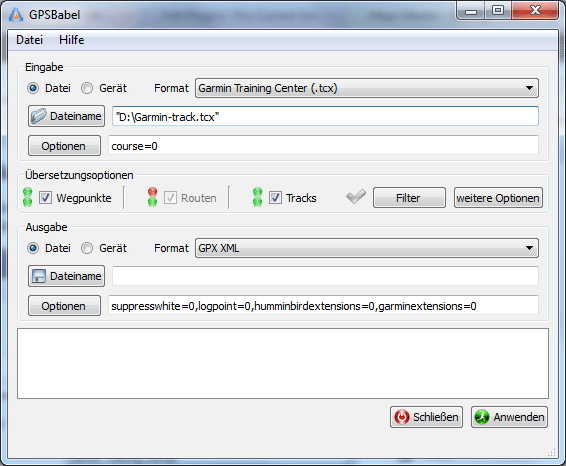

This is the algorith in action, interactively If the points have timestamp information that will not be discarded.
#Gpsbabel split track android
OpenSource GeoKarambola java library (no Android dependencies but can be used in Android) that includes a GpxPathManipulator class that does both route & track simplification/reduction (3D/elevation aware). If, say, you want to view the GPS activity within the same 1 square mile map area over 2 days instead, time resolution becomes half as important, so scale it down twice further, to 1/10,000,000. One day is 86400 seconds then to make the units equivalent, our prescale factor for your timestamp is. Conversion from degrees to surface distance is non-trivial, but for this case we simplify and say one degree is 60 miles then one mile is. Imagining this relationship as a cube of 1 mile by 1 mile by 1 day, you must prescale the time variable. You can resolve this discrepancy by deciding on an appropriate spatial-temporal relationship let's say you want to view one day of activity over a map area of 1 square mile. Your x and y coordinates will probably be in degrees of latitude/longitude, and the z (time) coordinate might be in seconds since the unix epoch. You can find a 3D C++ implementation here: 3D Douglas-Peucker in C++ If you find a Douglas-Peucker algorithm implemented in your language, it might have some 2D vector math implemented, and you'll need to extend those to use 3 dimensions. Logically, it's the same process in 3D as in 2D. This will require some simple vector operations. Then, you scan the points between B and I to find the furthest point from line segment AJ and scan points K through Y to find the point furthest from segment JZ, and so on, until the remaining points all lie within some desired distance threshold. Now scan through all remaining points B through Y to find the point furthest away from the line segment AZ. The simplest version of this path has two points, A and Z, so we start there. Say you have input path consisting of 26 points labeled A to Z. It's easy to extend the algorithm to the 3D case with a little understanding of how the algorithm works. I have done so for a web application of my own using a PHP implementation of Douglas-Peucker. But as you have pointed out, you will need to extend it to the 3D case to properly simplify a GPS track with an inherent time dimension associated with every point. Yes, as mentioned before, the Douglas-Peucker algorithm is a straightforward way to simplify 2D connected paths. Is there some ready-made utility / library / algorithm available to optimize tracks? Or may be I'm missing some clever option with gpsbabel? not checking that the speed was roughly constant). analyzing only geometrical shape of path, without timestamps (i.e. I thought of using gpsbabel for such track simplification / optimization job, but, alas, it's simplification filter works only with routes, i.e. There are myriads of points that can be deleted without losing almost anything: when there are several points making up roughly the straight line and we're moving with the same constant speed between them, we can just leave the first and the last point and throw away anything else. I understand that having several thousands of points of suboptimal. It works, but several thousands of points make using the map a sloppy and slow experience. Afterwards, I try to plot this track on a map and use it with OpenLayers. GPS receiver updates its coordinates every 1 second, gpxlogger's logic is very simple, it writes down location ( lat, lon, ele) and a timestamp ( time) received from GPS every n seconds ( n = 3 in my case).Īfter writing down a several hours worth of track, gpxlogger saves several megabyte long GPX file that includes several thousands of points. I've got a GPS track produced by gpxlogger(1) (supplied as a client for gpsd).


 0 kommentar(er)
0 kommentar(er)
